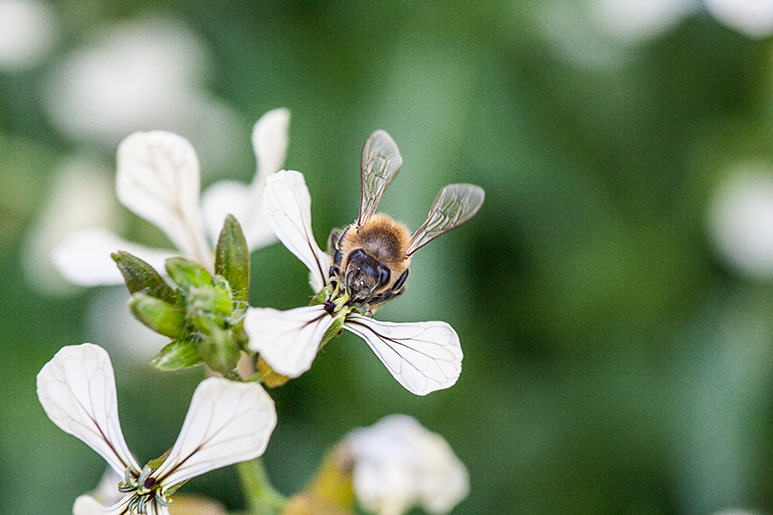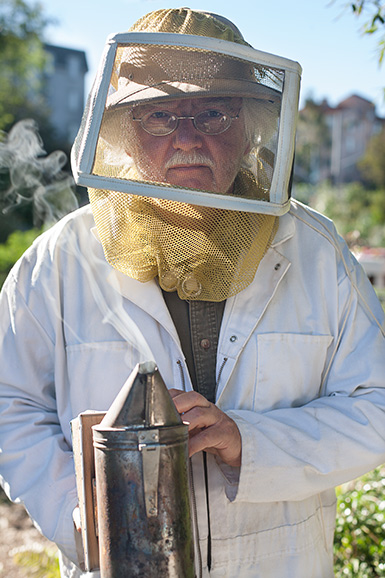Urban Beekeeping in LA is an important part of the Ecology of Saving Bees
Images by Jeff Skeirik/Rawtographer
It was 2006 when we first heard something really bad was happening to bees, yet no one could agree on what was causing their populations to decline so rapidly. By fortunate chance one thing did work in their favor: The concept of urban beekeeping had begun to take off. Suddenly, honeybees became part of the urban landscape. New York City legalized beekeeping, followed by other cities across the nation. In 2014, LA legislators voted to conduct a study on legalizing urban beekeeping in the city and they are currently making their way towards a vote to legalize the practice.
In Los Angeles, a beekeeper named Kirk Anderson had been rescuing wild hives and taking care of them without chemicals. He had been successful in harvesting all the honey he could use and then some. Word spread and soon Los Angeles had a new beekeeper club, The Backwards Beekeepers (of which Anderson is “Yoda-in-Chief”). They were backwards first because they did not use the chemicals modern commercial beekeepers use in the hives and second they tried to keep their hives as close to the natural environment bees would choose for themselves. Anderson had no formal training in beekeeping, but he did have a passion for bees along with an excellent and patient eye for observation. Backwards Beekeeping spread via an enthusiastic corps of new-bee beekeepers.

The really bad thing happening to bees was the sudden and mysterious arrival of Colony Collapse Disorder (CCD). Hives would appear to be industrious and thriving in the morning but would be vacated by early afternoon—all the adult bees vanished, no workers, no drones, no queen, only larvae, which cannot fly, left to die in the hive with supplies of untouched honey. Losses as high as 60% in many beekeeping operations were seen in professional and amateur hives alike. Beekeepers made new hives which ameliorated the losses, but from 2006, the losses have continued to range from 30 to 60% annually across the nation. A May, 2014, USDA survey reports that losses at this rate in the bee populations will eventually result in the demise of the honeybee.
What was causing Colony Collapse Disorder? Theories were rampant. Cell phones. Cell phone towers. Insecticides. Round Up. Beekeeping, following in the industrial agricultural model had adopted the use of miticides and fungicides to help the bees cope with some of their natural enemies. Scientific studies came to opposite conclusions. Yet, urban beekeepers had some losses but demonstrably fewer than rural operations.
The actual causes finally seem to be coming into focus. Scientists have learned that the pesticides we used on the bees to help them fight their natural predators might be a large part of the problem, justifying Kirk Anderson’s natural beekeeping methods. Furthermore, a new class of pesticide, with the practically unpronounceable name of neonicotinoids (we call them neonics), probably has a lot more to do with the bee’s demise than any one other thing. Italy recently banned the use of neionics in their country. This is only the second year of the ban, so results are not in yet, but a lot of bee enthusiasts are watching how this will play out.
 It may be the urban beekeepers that save the honeybee from total collapse. Certainly many urban beekeepers will cite this as one of the top 10 reasons to become a beekeeper, along with comments about the relaxing nature of the work: A beekeeper doesn’t want to fight with the bees and so needs to adopt a calm and purposeful attitude with the open hive. Causing as little disruption as possible while working requires an attention to the hive and the thousands of bees there. This work is often described as a meditation.
It may be the urban beekeepers that save the honeybee from total collapse. Certainly many urban beekeepers will cite this as one of the top 10 reasons to become a beekeeper, along with comments about the relaxing nature of the work: A beekeeper doesn’t want to fight with the bees and so needs to adopt a calm and purposeful attitude with the open hive. Causing as little disruption as possible while working requires an attention to the hive and the thousands of bees there. This work is often described as a meditation.
Considering all of this, Kirk Anderson comes off as a genius. He was teaching nascent beekeepers to find a feral hive, adopt it, put it in a box, skip the chemicals, and just work with the bees the way the bees would to do it on their own. Bees in the city are not subjected to the mass spraying of pesticides like the ones in rural sites, and many of the agricultural chemicals sprayed are known to kill bees. Even if a homeowner in the city sprays his lot, the lot next door is not sprayed—it’s a matter of square feet, not square miles—and many homeowners will not spray at all (especially in Los Angeles where the malathion spraying in the 1990s made such headlines).
Natural beekeeping practices are essential to our ecosystem since honeybees are essential to our modern food production. Not native to America, the honeybee was brought to the continent by the Europeans. Native American bees are numerous, but do not produce honey and do not live in colonies like those species that make honey. It is the honeybee’s way of working, however, that connects her (because all the worker bees are female) most closely to our way of farming.
The honeybee worker daily gathers pollen and nectar for the hive’s food, staying on whatever flower variety she visits first until she can find no more, so if her day starts with a plum flower, she will continue to visit plum flowers until she runs out of those flowers to visit. This makes them pollination powerhouses. Compared to the American bees who do not produce honey, the honeybee is miraculous. In contrast, a native American orchard bee will gather from everything without regard to species. The orchard bee will start with a mustard flower and go to a sage, hang out with the plum tree and go off a rose. This is not the efficiency that is loved by orchard owners. Furthermore, because the honeybee lives in a hive, when bees return to the hive in the evening, they can be sealed inside, and the entire colony (or many colonies) can be sent from orchard to orchard depending on the flower’s bloom time.

In Los Angeles, beekeeping is a gray area. There are no laws against it, but no laws for it. While Santa Monica has legalized beekeeping and regulated it, LA has moved much more slowly. HoneyLove, the honey-loving efforts of Rob and Chelsea McFarland, has greatly advanced the call to legalize beekeeping in Los Angeles. The couple has become one the leading proponents for Kirk Anderson’s type of beekeeping. Rob has taught a number of workshops and continues to teach the science and art of beekeeping. Most of their hives are in more rural areas of the county, which provide space for students and bees to congregate together and learn.
Between Kirk Anderson, his many students, and advocates Rob and Chelsea McFarland, many more Angelenos are keeping bees. A kept bee, versus a feral bee, has a much smaller chance of running afoul of humans. Bees in boxes maintained by a beekeeper will be provided a safe home and a supply of water since water, of all the things bees need, tends to be in the shortest supply. Bees end up trying to get a drink from a swimming pool—often losing their lives in the attempt. A beekeeper makes certain their hives have their own access to clean, fresh water, which is important since water is the place where most negative interactions between humans and bees occur.
Honeybees are fascinating. They’re not really kept as pets—they lack the cuddliness of a puppy or kitten—but as a part of our ecology, they teach and fascinate. They make our fruit and nut trees more productive. When we abdicated control over how what we eat is grown, we did not have a clue that we were going to treat that food with a saturation of chemical goo and create questionable foods that nature did not make, just to profit on our need to eat. Now, we have begun to wake up, shorten the length of the journey from creation to table, becoming much more intimately involved with what eat and the nature that flows through our food and our city.
Like a meditation, our interactions with the plants and creatures that live around us push us gently toward an understanding of what we eat. People decry the city for the lack of nature and while it may not be a truly natural environment nature is resourceful and you can see nature somewhere today (wherever you are) by finding a honeybee on a rosemary flower ignoring you and doing the work she knows to do.
Plus, you get honey.
David King draws upon 50 years of gardening experience and his love of plants and food for all he does. He is the Gardenmaster of the Learning Garden on the grounds of Venice High School, he teaches growing food for UCLA and UC Extension and is the founding chair of the Seed Library of Los Angeles. His first book, Growing Food in Southern California (and other Mediterranean Climates) is expected out some time before our grandchildren leave college. thelearninggarden.org; slola.org; lagardenblog.com
